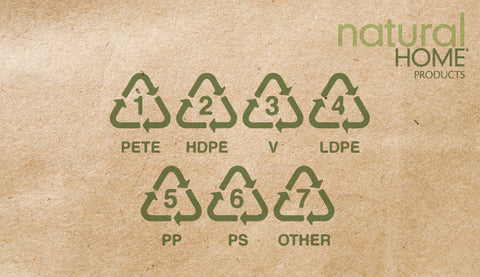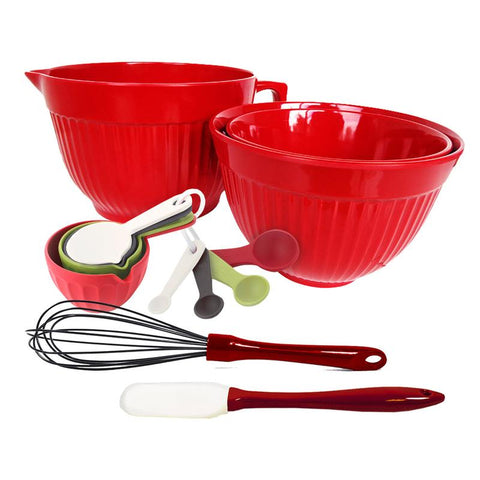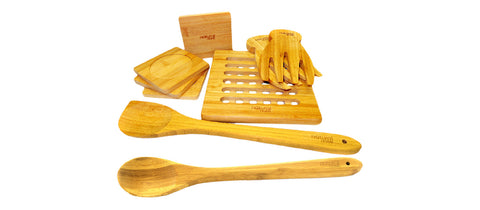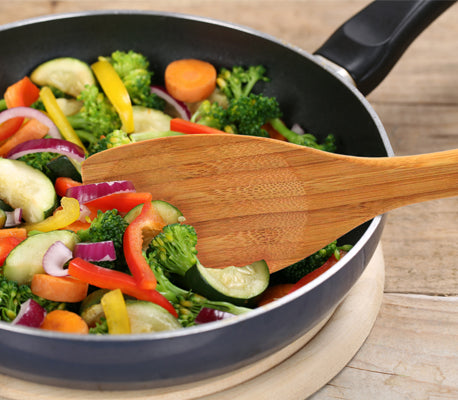NHB's ECO FRIENDLY News Blogs — Bamboo
MAKE IT MONDAYS I TERRIFIC TIPS TUESDAY I WACKY WEDNESDAYS I THRIFTY THURSDAYS I FACT OR FICTION FRIDAYS
Recycle Numbers On The Bottom Of Plastics
Ever wonder what those little numbers on the bottom of food containers, cups, and plastics are?
Here's a guide to what they mean!
Did you know that the use of plastics should be limited if at all possible, but some are safer than others?!
Let's learn a little bit about the multiple plastics we use to eat and drink from on a day to day basis and the type of impact they have on you, and the environment.
Every plastic container or bottle has a recycling symbol. This symbol is a number ranging from 1 to 7 within a triangle. These little numbers can actually offer a great amount of information in regards to toxic chemicals used in the plastic, how likely the plastic is to leach these chemicals, how bio-degradable the plastic is, and conclusively, the safety of the plastic.

Look for these numbers before you buy!
Safer choices are symbolized with a 1,2,4 and 5
Avoid 3,6 and most plastics labeled 7 (some labeled #7 are in fact compostable, it usually states this on the packaging or container)
The Meanings of The Recycling Symbols:
Plastic #1 - PETE or PET (Polyethylene Terephthalate) Yes- Recycle this
-
A plastic resin and the most common type of polyester.
-
Widely accepted by the majority of curb side pick ups
-
Many water bottles, beverages, food items (peanut butter containers, salad dressing bottles, fruit containers), & other consumer products (like shampoo bottles & mouthwash containers) are constructed with packaging made from PET.
-
Manufactures use this because it's strong, transparent, & versatile. Some consider it safe, but this plastic is known to collect bacteria that accumulates.
-
Up to 100% of PET packaging can be made from recycled PET. This plastic can be recycled again & again. It's also recycled into carpeting fibers, t-shirt fabrics or fleece jackets, dog beds, winter coats, and automotive parts such as door panels & bumpers. [1]
-
The longer a liquid is left in a PET container, the greater chances Antimony Trioxide (used as flame retardant or catalyst) is released, same with warm temperatures like inside cars, garages, and enclosed areas.
Plastic #2 - HDPE (High Density Polyethylene) - Yes Recycle This
-
A polyethlene thermoplastic made from petroleum - One of the most commonly used plastics in the United States
-
Widely accepted by curbside pickups
-
Typically found in milk jugs, plastic bags, refillable plastic bottles, detergent bottles, yogurt tubs, plastic lumber, lawn & garden products, buckets & crates.
-
Plastic #2 is typically opaque in color, and is picked up by most curbside recycling programs.
-
This plastic is one of the 4 plastics that is considered to be safe and has a lower risk of leaching. Some studies have shown that this can leach the endocrine disruptor nonylphenol in both aquatic and human life, especially when exposed to sunlight.
-
It resists insects, rot, & other chemicals
-
By recycling your #2 plastics, you help create new: pens, recycling containers, detergent bottles, lumber, fencing, water pipes, fireworks plus more. [2]
-
Some alternatives you can use to avoid this plastic are glass or stainless steel reusable water bottles and food storage containers, and use recycled bags. Recycle plastics with #2 if you must use them.
Plastic #3 - V or PVC (Vinyl)- Not Usually Picked Up Curbside Polyvinyl chloride - the third most widely produced synthetic plastic made of 57% chlorine & 43% carbon.
-
Most commonly used to made drainage/sewage/plumbing pipes, food wrap, and detergent bottles, chemical storage tanks & plant piping; PVC has excellent chemical resistance together with good mechanical properties, making this an ideal for all the listed above.
-
Human Health : Dioxins are created in the manufacturing and production of PVC. Dioxins are highly toxic and can lead to developmental and reproductive disease, immune system damage, and cancer. [3]
-
Dumping PVC in landfill takes up a lot of land and is a waste of a valuable resource. PVC compounds are 100% recyclable. Most PVC products are lightweight and take up a lot of space, and may lasts for hundreds of years without degrading.
-
PVC can be recycled into: cables, flooring, park benches, speed bumps & traffic cones, film plastic, and decking & fencing. [4]
-
It's recommended to avoid as it can be extremely toxic - especially when burned (car and home fires, waste incineration, etc).
-
Once burned, dioxins are formed, which are human carcinogens and organic pollutants - these are considered one of the most toxic types of chemicals ever tested. It only takes 5 ounces of burning PVC to give off enough hydrogen chloride gas to kill the occupants in an average size bedroom in ten minutes. [PVC]
Plastic # 4 - LDPE (Low Density Polyethylene) - Often Picked Up Curbside - Varies from location to location
-
Most commonly found in squeeze bottles, toys, carrier bags, high frequency insulation, chemical tank linings, general packaging, gas & water pipes, food container lids, clear plastic bags, and shrink wrap. Fresh milk cartons and juice cartons are made with paperboard coated with LDPE film, making the cartons leak-proof. [5]
-
Plastic #4 is among one of the recycling symbols that are considered to be safe. Since it is found in many consumer products as well as packaging, it is likely that everyone uses plastic products or handles packaging made with LDPE daily. The U.S. Food and Drug Administration (FDA) and European Union food closely regulate the evaluation of these plastics.
-
LDPE is recycled into: compost bins & garbage cans, film plastic, furniture, paneling, plastic lumber, shipping envelopes, and garbage can liners. [6]
Plastic #5 - PP (Polypropylene) - Often Picked Up Curbside - Varies from location to location
One of the safer plastics to use & is recyclable.
-
Widely accepted by curbside pickups
-
Typically found in packaging & labels, textiles (rope & carpet), stationary, reusable containers, laboratory equipment, yogurt containers, ketchup bottles and medicine bottles.
-
PP # 5 can be recycled into: plastic lumber, car battery cases, manhole steps, and signal lights.
Plastic #6 - PS (Polystyrene) - Not Usually Picked Up Curbside
-
Naturally a transparent thermoplastic that is available as a solid plastic as well in as in the form of a rigid foam material (Styrofoam). These items are difficult to recycle - not biodegradable, taking several decades of hundreds of years to deteriorate. This type of plastic can also pose as health risks, leaching potentially harmful toxic chemicals, especially when heated.
-
Most commonly found in egg cartons, meat trays, disposable paper plates & cups (to-go boxes), medical test tubes, CD cases, smoke detectors, and the red "solo" cup. [7]
-
The foam form is often used as a packing material such as "packing peanuts"
-
Best to avoid whenever possible, especially with hot items, such as a hot coffee cup made of Styrofoam . It can leach styrene, a known nuerotoxin with other harmful health effects. [8]
-
PS can be recycled into: flower pots, cassette tapes, and plastic lumber.
Plastic #7 - Other, Miscellaneous - Not Usually Picked Up Curbside
-
This category was designed for all the other plastics, so reusing and recycling are not standardized. The most common concern with plastic #7 is the potential for chemical leaching into food or drink products packaged in containers made using polycarbonate, which contains the toxic bisphenol-A BPA. BPA is a xenoestrogen, a known endocrine disruptor - linked to infertility, hyperactivity, reproductive problems, and other health issues.
-
New plastic alternatives are marked with symbol 7 as well; this includes compostable green products, made from corn potatoes, rice, or tapioca.
-
Plastic #7 can be found in baby bottles, water bottles, iPod cases, nylon, sunglasses, "microwavable" dishes, some tupperwares and squeeze ketchup bottles. [9]
Remember, whatever plastics you choose, never heat them in the microwave or expose them to other extremes stresses, like keeping them in a hot car or hot garage. Always recycle or throw away containers once they start to break down or crack.
Choose from any of our all Natural and Ecofriendly Kitchen Gadgets - made with all natural bamboo fibers, and rice starches. Never coated with any chemicals and completely safe for your family, friends, and pets!
100% chemical free
(which means NO toxins or chemicals to leach!)

Plastic Free Kitchen Collection
Some other articles you might enjoy:
Things You Can & Cannot Recycle
Why Are You Still Using Plastic In Your Kitchen?
Plants That Help Purify & Clean the Air
References:
1 http://www.napcor.com/PET/whatispet.html
2 http://bearboardlumber.com/bearboard-plastic-advantage/what-is-hdpe.html
3 Dioxins and their effects on human health. (2010, May). Retrieved July 7, 2010, from World Health Organization: http://www.who.int/mediacentre/factsheets/fs225/en/index.html - See more at: http://www.ecolife.com/recycling/plastic/how-to-recycle-pvc-plastic-3.html#_ednref5
4 http://www.pvc.org/en/p/what-is-pvc
5 http://msdssearch.dow.com/PublishedLiteratureDOWCOM/dh_091f/0901b8038091f9e0.pdf?filepath=productsafety/pdfs/noreg/233-00587.pdf&fromPage=GetDoc
6 http://www.ecolife.com/recycling/plastic/how-to-recycle-ldpe-plastic-4.html
7 http://www.creativemechanisms.com/blog/polystyrene-ps-plastic
8 http://isites.harvard.edu/fs/docs/icb.topic967858.files/PolystyreneFactSheets.pdf
9 http://learn.eartheasy.com/2012/05/plastics-by-the-numbers/
Other References:
http://www.healthychild.org/know-your-plastics/
http://naturalsociety.com/recycling-symbols-numbers-plastic-bottles-meaning/
http://greenveg.com/know-your-plastic-recycling-number/
- Gabriella De Luca
- Tags: Bamboo EcoFriendly Molded Bamboo
Bamboo Utensils VS Wood Utensils
Bamboo utensils have increasingly become more popular over the years. More and more people are turning to bamboo instead of wood for loads of reasons!
-
Unlike wood, bamboo is not a tree, but actually a grass - but don't be fooled! Bamboo was actually used as reinforcement for concrete instead of steel at one point, and was also used to support bridges (comparably just as strong as steel).
-
Bamboo can grow as much as 35 inches in 24 hours vs 3' to 4' per year for trees that harvest wood
-
An entire bamboo forest can be regenerated in three to five years
-
Bamboo reaches it's full level of maturity before harvesting - about 5-7 years (Wood is about 30 years until harvest)
-
Because Bamboo is naturally anti-bacterial & anti-fungal, bamboo is grown without the use of toxins, pesticides, or fertilizers, as opposed to wooden products.
-
Bamboo is less porous than wood, making them water resistant and stain resistant.
-
Bamboo is stronger than any oak, or wood, and actually has a higher *tensile strength than steel (Bamboo's tensile strength is 28,000 per square inch, and steel's strength is 23,000 per square inch)
-
Absorbs very little moisture, so it won't shrink unlike it's wooden counterparts.
-
Bamboo is harder than maple and oak which makes it the ideal material for a lighter weight, stronger, and superior choice for kitchen utensils and cutting boards when trying to decide between bamboo and wood.

Other Blogs You Might Enjoy:
How To Clean & Care For Your Bamboo
Natural Home Bamboo and Molded Bamboo® makes Going Green in your kitchen so simple!
Get 15% off any Bamboo Item using code Bamboo at checkout
With the rising concern of how potentially harmful plastics can impact our bodies and our planet, Bamboo and Natural Home's Molded Bamboo® offers a healthy alternative, free from BPA's, toxic coatings, and always manufactured responsibly.
We only harvest our Bamboo when it's fully matured, and construct our Molded Bamboo® items out of only bamboo fibers and natural dyes.
*tensile strength definition: the resistance of a material to breaking under tension*
Information gathered and adapted from:
Profitableplantsdigest.com
ehow.com
Midatlanticbamboo.com
- Gabriella De Luca
- Tags: Bamboo EcoFriendly Moboo Molded Bamboo
How To Clean & Care For Your Bamboo
Since bamboo is actually a strong grass-not a wood, and is a natural resource, washing and taking care of these utensils are similar to taking care of wooden utensils. However, don't get the two confused! Compare the differences here! You can keep your bamboo utensils looking nice and new by cleaning them and conditioning them as needed.
It's always STRONGLY recommended that you DO NOT wash bamboo in the dishwasher - the harsh detergents and heat is way too much for our bamboo kitchen friends.
Some Items To Have On Hand:
-
Dish Soap (Get pH Balanced Dish Soap)
-
Cloths for drying
-
Food Grade Mineral Oil or Bamboo oil
Step 1:
Use a regular mild dish soap or a pH balanced soap, and wash your bamboo utensils in soapy hot water. Use a cleaning cloth to scrub away stuck on food particles. (Get an EcoFriendly REUSABLE Cloth)
Step 2:
Rinse your bamboo utensils in warm water. Pat-Dry the utensils with a clean cloth to the best of your ability, then stand them up right in your dish dryer/drainer to complete the drying process.
Step 3:
If your bamboo utensils start to look or feel dry, re-hydrate them with mineral oil, or bamboo conditioning oil (found in most kitchen supply stores). To use the oil, apply several drops to a clean cloth and rub all over your utensil. Repeat this process if necessary. Let the utensil cure for a day or two before using again.
Recommendations:
-
If possible, rinse your bamboo utensils right after use to prevent food from getting stuck on
-
Use your nail or the dull side of a knife to scrape off stuck on food
-
Try to not let your bamboo sit in water for an extended amount of time (i.e. left in a bowl of water/at the bottom of the sink) this may cause your utensil life to shorten
-
Set aside a separate crock, or area for dirty bamboo utensils
-
Avoid cooking raw eggs and raw meat - if you must, washing your utensils in a bleach solution is recommended (about 1 teaspoon of liquid bleach per quart of water, 5mL per liter). Rinse thoroughly afterwards.
Shop Our Bamboo Line
Get 15% off any Bamboo Item using code Bamboo at checkout

Some Other Articles You Might Enjoy:
Eliminating Food Waste IS Doable
- Gabriella De Luca
- Tags: Bamboo Ecofriendly How-To
Why Choose Bamboo?
Materials like Teflon, lead, BPA, aluminum, melamine, and phthalates are regularly found in everyday kitchenware products. After spending a great amount time of choosing, shopping, & preparing nutritious foods for your family, there can be nothing more disheartening than learning that the products we are using to cook, bake, store, serve, and eat with my potentially put our families' health at risk.
Making the Green switch can be easy!
Bamboo utensils are unlike any other type of kitchen utensil because:
-
Bamboo is a sustainable material - (Bamboo is the fastest growing plant on the planet. It can grow 3 feet in height in 24 hours under appropriate climate conditions. Unlike other woody plants, bamboo reaches maturity after only 3 to 5 years.)
-
Lightweight & Durable (outlasts wood competitors)
-
Attractive alternative to hard wood, plastic, and metal utensils.
-
Bamboo will not scratch your non-stick cookware and are quite simple to take care of.
-
Bamboo does NOT leach chemicals - since there's no chemicals to leach!
-
Biodegradable - These will not harm the environment during the break down process
-
Water & Stain Resistant (absorbs very little moisture)
-
Does not conduct heat (leave in your pot, and the utensil's handle won't burn you)
-
Versatile - from spoons, to cutting boards, to plates, the love for bamboo seems to be growing!
Get 15% off any Bamboo Item using code Bamboo at checkout
- Gabriella De Luca
- Tags: Bamboo
